#Lora Module 868MHz-915MHz
Text
How much do you know about LoRa1262 and 1268? A detailed selection guide to help you learn more
LoRa1262 and LoRa1268 are ultra-low power wireless rf module designed with Semtech's SX1262 and SX1268X chips. They support both (G)FSK modulation and LoRa modulation. The LoRa modulation significantly extends communication range, making it suitable for various short-range IoT wireless communication applications. They feature small size, low power consumption, long transmission distance, and strong anti-interference capability.
Industrial crystals and supported frequency bands
SX1262 and SX1268 both utilize industrial-grade high-precision crystals. They can wake up the microcontroller on a timed basis while operating at low power. The module's antenna switch is internally integrated and controlled by the chip, saving external MCU resources. With compact size and 22dBm output power, they offer significant advantages in IoT and battery-powered applications.
SX1262 supports frequency bands in the range of 868MHz (customizable from 150MHz to 960MHz)
SX1268 supports frequency bands in the range of 433/490MHz (customizable from 410MHz to 810MHz)
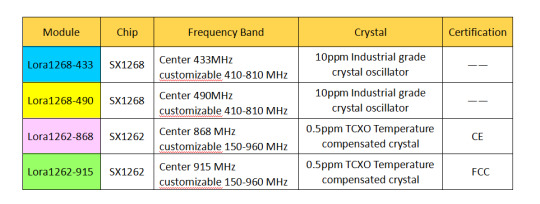
According to the table above, it can be seen that LoRa1262 wireless rf module is equipped with a 0.5ppm TCXO temperature-compensated crystal oscillator, suitable for applications requiring extremely high accuracy, such as communication base stations and precision instruments. LoRa1262 has passed CE and FCC certifications for both the 868MHz and 915MHz frequency bands, meeting regulatory requirements for wireless devices in overseas markets.
SX1262 and SX1268 features
Small Size
The RF chip measures 4mm x 4mm, which is 45% smaller compared to the SX127x series ICs.
Low Receive Power Consumption
The RF receive power consumption is 4.8mA, which is more than halved compared to the SX127x series' 10mA receive current.
High Receiver Sensitivity
With a maximum sensitivity of -148dBm, it significantly enhances communication range.
High Data Rate
In LoRa mode, the maximum achievable data rate is 62.5kb/s with different spreading factors, and in GFSK mode, it supports up to 300kbps, programmable by the user. High Output Power: Capable of reaching a maximum output power of +22dBm, programmable by the user.
Selective Wake-up
Supports hardware address recognition, enabling selective wake-up functionality for the module.
Low Power Consumption
During sleep mode, the minimum power consumption is as low as 160nA.
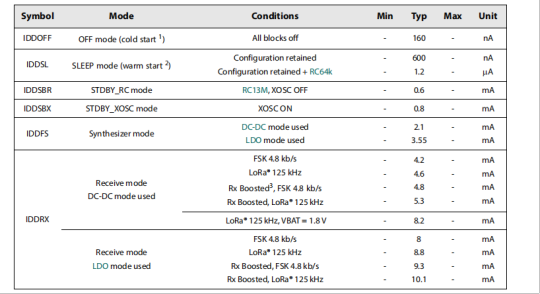
The chart above shows the current consumption of LoRa1262/1268 modules, indicating two power management modes: LDO and DC-DC.
Under DC-DC mode, the minimum current consumption during FSK modulation with 4.8 kb/s data transmission is 4.2mA. For LoRa modulation with a 125kHz signal bandwidth and voltage of 1.8V, the receive current is 8.2mA. In Boosted mode, there is a slight variation in current for both LoRa and FSK modulation.
Similarly, under LDO mode, the minimum receive current is observed during FSK modulation, and under Boosted mode with LoRa modulation and 125kHz signal bandwidth, the receive current is 10.1mA.
It can be concluded that the key feature of LoRa1262 and LoRa1268 wireless rf module is low power consumption, with a minimum receive current of 4.2mA. They are suitable for low-power applications. Additionally, these modules can be equipped with industrial-grade temperature-compensated crystal oscillators, meeting the requirements of high-precision industrial applications.
We hope the above comparison analysis is helpful. For further information, please refer to the product specification sheet or contact us directly:
For details, please click:https://www.nicerf.com/products/
Or click:https://nicerf.en.alibaba.com/productlist.html...
For consultation, please contact NiceRF (Email: [email protected]).
0 notes
Text
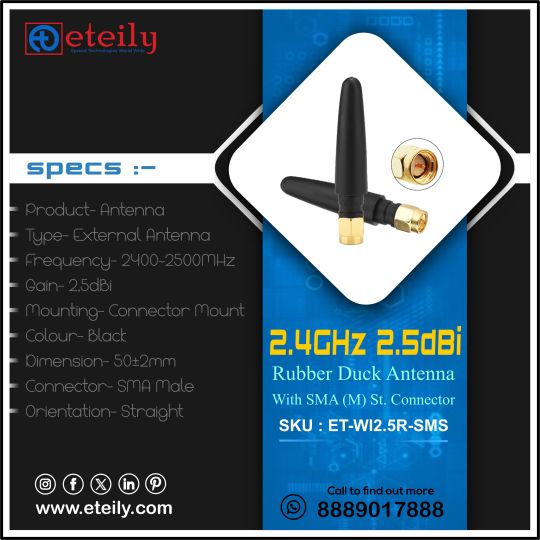
2.4GHz 2.5dBi Rubber Duck Antenna Manufacturers
A "rubber duck" antenna is a type of omnidirectional antenna commonly used in radio communication devices, such as two-way radios and Wi-Fi routers. It is named "rubber duck" due to its flexible, rubbery exterior. These antennas are typically short, stubby, and have a helical coil design.
Key characteristics of a rubber duck antenna include:
Omnidirectional Radiation Pattern: Rubber duck antennas are designed to radiate signals in all directions, providing a 360-degree coverage pattern. This makes them suitable for applications where the signal needs to be transmitted or received from various directions.
Compact Size: Rubber duck antennas are relatively short and compact compared to some other types of antennas. This makes them convenient for portable devices and equipment where space is limited.
Flexible Design: The flexibility of the rubber duck antenna allows it to withstand bending and flexing without breaking. This makes it more durable for portable and handheld devices.
Wide Usage: Rubber duck antennas are commonly used in applications such as handheld radios (walkie-talkies), portable scanners, and Wi-Fi routers. They are often detachable and can be replaced with antennas of different lengths or types for specific needs.
Frequency Range: The design of rubber duck antennas allows them to operate within specific frequency ranges. Different antennas may be optimized for different frequency bands, such as those used for VHF (Very High Frequency) or UHF (Ultra High Frequency) communication.
It's important to note that while rubber duck antennas are versatile, their performance may not be as specialized as larger or more directional antennas. The choice of antenna depends on the specific requirements of the communication system, such as range, directionality, and the frequency of operation.
#rubber duck antenna#Rubber ducky antenna#9dBi GSM Rubber Duck Antenna#3dBi Gain Rubber Duck Antenna#Rubber Duck Antennas#Rubber Duck Antenna Gsm-2 DBI#2.4 GHz Rubber Duck Omni Antennas#900 MHz 3 dBi Rubber Duck Antenna#Rubber Duck Antenna Manufacturer#High-Performance Wi-Fi Rubber Duck Antennas#4G/5G Rubber Duck Antenna#Top Rubber Duck Antenna Manufacturers#865 – 868 MHz / 1dBi Gain Rubber Duck Antenna#Rubber Duck Antenna in Mumbai#3DBI GSM rubber Duck antenna 800#External Rubber Duck Antenna#Dual Band White Rubber Duck Antenna#868 Mhz Rubber Duck Antenna#rubber duck antenna in india#rubber duck antenna in delhi#rubber duck antenna in chennai#rubber duck antenna in bangalore#rubber duck antenna in Ahmedabad#rubber duck antenna in hyderabad
0 notes
Text
[Media] TTGO T-Beam ESP32 LoRa
TTGO T-Beam ESP32 LoRa
The TTGO T-Beam is a long-range wireless capable board supporting LoRa, built around a dual-core ESP32 chip with 4MB of SPI flash onboard, providing both Wi-Fi and Bluetooth LE.
The board's LoRa support comes in three different variants, operating at 433MHz, 868MHz, and 915MHz depending on region, with an included SMA antenna. Location tracking is provided by the onboard u-blox NEO-6M GPS module with ceramic antenna, and the board offers 26-pin headers with GPIO, ADC, VP/VN, DAC, touch, SPI, I2C, UART, 2דLoRa” pin, and power signals (5V/3.3V/GND).
The board can be programmed using the Arduino development environment, and example code shows you how to both send and receive data via LoRa. The board also includes a battery holder for a 18650 Li-Ion cell.
Repository:
https://github.com/Xinyuan-LilyGO/LilyGo-LoRa-Series
Buy online:
🛒 https://alii.pub/6mgzin
🛒 https://amzn.to/3Z2WUh4
#radio #lora #mesh #ESP32

0 notes
Text
Lllc68 – Module sans fil LoRa 868MHz 915MHz, 22dbm, longue portée 5km, CDSENET E220-900T22D SMA-K UART RSSI émetteur récepteur DIP
Lllc68 – Module sans fil LoRa 868MHz 915MHz, 22dbm, longue portée 5km, CDSENET E220-900T22D SMA-K UART RSSI émetteur récepteur DIP
window.adminAccountId=230137393;

View On WordPress
0 notes
Text
LoRaWAN LoRa Module EUROPE Market Research Report 2021-2026
Due to the high popularity of this product/service in North America and Asia, the growth trend of LoRaWAN LoRa Module in recent years and the growth of consumers' demand is expected to drive the global LoRaWAN LoRa Module market.
ALSO READ: http://www.marketwatch.com/story/lorawan-lora-module-market-research-report-with-size-share-value-cagr-outlook-analysis-latest-updates-data-and-news-2021-2028-2021-07-13
Geographically, the global LoRaWAN LoRa Module market is divided into North America, Europe, Latin America, Asia Pacific, Middle East & Africa.
North America, Asia and Europe have significant position in the this market, big players operating in there. The U.S. is accounting for a major share of the total LoRaWAN LoRa Module market in North America.
Significant participants active in the global LoRaWAN LoRa Module market include: Embit, Nicerf, Manthink, Multi-Tech Systems, Lairdtech, Hope Microelectronics, Link Labs, Libelium, Nemeus, Murata, Microchip Technology, Dapu Telecom Technology, Imst Gmbh...
ALSO READ: http://www.marketwatch.com/story/enterprise-medical-software-market-research-report-with-size-share-value-cagr-outlook-analysis-latest-updates-data-and-news-2021-2028-2021-07-21
Global LoRaWAN LoRa Module Market Segmentation:
LoRaWAN LoRa Module market, by LoRaWAN LoRa Module type:
433MHz
470MHz
868MHz
915MHz
923MHz
Others
…
LoRaWAN LoRa Module market, by Application:
Internet of Things
Smart Agriculture
Smart City
Industrial Automation
Smart Meters
Asset Tracking
Smart Home
Sensor networks
M2M
…
ALSO READ: http://www.marketwatch.com/story/ski-gear-and-apparel-market-research-report-with-size-share-value-cagr-outlook-analysis-latest-updates-data-and-news-2021-2028-2021-07-21
LoRaWAN LoRa Module Market Research Report 2014-2026, by region:
North America
The U.S.
Canada
Europe
Germany
UK
France
Italy
Spain
Rest of Europe
Latin America
Mexico
Brazil
Argentina
Pan Asia Pacific
China
Japan
South Korea
South East Asia Region
India
Australia
Middle East and Africa
Saudi Arabia
UAE
Qatar
Egypt
Nigeria
South Africa
Rest of MEA
The database is running updated by a group of research experts to always reflect the latest trends and information.
Table of Contents
1. Introduction
1.1 Definition of the Market
1.2 Research Purpose
1.3 Scope of the Study
1.4 Stakeholders
1.5 Geography Coverage
1.6 Currency Under Consideration
1.7 Volume Units
1.8 Review Cycle
1.9 Summary and Key Findings of the Research
2 Research Methodology
2.1 Research Data
2.1.1 Secondary Data
2.1.2 Primary Data
2.2 Market Size Estimation
2.2.1 Bottom-Up Approach
2.2.2 Top-Down Approach (Involves time, Space, and Persons)
2.3 Data Triangulation
2.4 Assumptions
2.5 Hypothesis of this Research, Clear, Specific, and Testable Statement of This Research
2.6 Limitations of Our Study
2.7 Scene Based Modeling
2.8 Covid-19 Impact/Evaluation
3. Market Dynamics
3.1 Driving Factors
3.1.1 Rising Demand in one or More of the Following Regions: North America, Europe, Asia-Pacific, Latin America, Middle East & Africa
3.1.2 Increasing Use of LoRaWAN LoRa Module by Different End-User/Applications
3.2 Restraints and Challenges in the Market
3.3 Opportunities
4. Global LoRaWAN LoRa Module Market-Segmentation
4.1 By Type
4.1.1 433MHz
4.1.2 470MHz
4.1.3 868MHz
4.1.4 915MHz
4.1.5 923MHz
4.1.6 Others
4.2 By End-User/Application Industry
4.2.1 Internet of Things
4.2.2 Smart Agriculture
4.2.3 Smart City
4.2.4 Industrial Automation
4.2.5 Smart Meters
4.2.6 Asset Tracking
4.2.7 Smart Home
4.2.8 Sensor networks
4.2.9 M2M
4.3 By Geography
4.3.1 North America LoRaWAN LoRa Module Total Market Size (Production, Consumption, Import, Export) and Segmentation (by Type, Application, Countries and Participants)
4.3.1.1 North America LoRaWAN LoRa Module Production from 2014-2020
4.3.1.2 North America LoRaWAN LoRa Module Consumption from 2014-2020
4.3.1.3 North America LoRaWAN LoRa Module Import and Export from 2014-2020
4.3.1.4 North America LoRaWAN LoRa Module Market Value ($) and Growth (%) by Type from 2019-2020
4.3.1.5 North America LoRaWAN LoRa Module Market Value ($) and Growth (%) by Application from 2019-2020
4.3.1.6 North America LoRaWAN LoRa Module Market Value ($) and Growth (%) by Countries from 2019-2020
4.3.1.7 Top North America LoRaWAN LoRa Module Participants Value ($) and Market Share (%) in 2019
4.3.2 Europe LoRaWAN LoRa Module Total Market Size (Production, Consumption, Import, Export) and Segmentation (by Type, Application, Countries and Participants)
4.3.2.1 Europe LoRaWAN LoRa Module Production from 2014-2020
4.3.2.2 Europe LoRaWAN LoRa Module Consumption from 2014-2020
4.3.2.3 Europe LoRaWAN LoRa Module Import and Export from 2014-2020
4.3.2.4 Europe LoRaWAN LoRa Module Market Value ($) and Growth (%) by Type from 2019-2020
4.3.2.5 Europe LoRaWAN LoRa Module Value ($) and Growth (%) by Application from 2019-2020
4.3.2.6 Europe LoRaWAN LoRa Module Market Value ($) and Growth (%) by Countries from 2019-2020
4.3.2.7 Top Europe LoRaWAN LoRa Module Participants Value ($) and Market Share (%) in 2019
4.3.3 Asia-Pacific LoRaWAN LoRa Module Total Market Size (Production, Consumption, Import, Export) and Segmentation (by Type, Application, Countries and Participants)
4.3.3.1 Asia-Pacific LoRaWAN LoRa Module Production from 2014-2020
4.3.3.2 Asia-Pacific LoRaWAN LoRa Module Consumption from 2014-2020
4.3.3.3 Asia-Pacific LoRaWAN LoRa Module Import and Export from 2014-2020
4.3.3.4 Asia-Pacific LoRaWAN LoRa Module Value ($) and Growth (%) by Type from 2019-2020
4.3.3.5 Asia-Pacific LoRaWAN LoRa Module Value ($) and Growth (%) by Application from 2019-2020
4.3.3.6 Asia-Pacific LoRaWAN LoRa Module Value ($) and Growth (%) by Countries from 2019-2020
4.3.3.7 Top Asia-Pacific LoRaWAN LoRa Module Participants Value ($) and Market Share (%) in 2019
4.3.4 Latin America LoRaWAN LoRa Module Total Market Size (Production, Consumption, Import, Export) and Segmentation (by Type, Application, Countries and Participants)
4.3.4.1 Latin America LoRaWAN LoRa Module Production from 2014-2020
4.3.4.2 Latin America LoRaWAN LoRa Module Consumption from 2014-2020
4.3.4.3 Latin America LoRaWAN LoRa Module Import and Export from 2014-2020
4.3.4.4 Latin America LoRaWAN LoRa Module Value ($) and Growth (%) by Type from 2019-2020
4.3.4.5 Latin America LoRaWAN LoRa Module Value ($) and Growth (%) by Application from 2019-2020
4.3.4.6 Latin America LoRaWAN LoRa Module Value ($) and Growth (%) by Countries from 2019-2020
4.3.4.7 Top Latin America LoRaWAN LoRa Module Participants Value ($) and Market Share (%) in 2019
4.3.5 Middle East & Africa LoRaWAN LoRa Module Total Market Size (Production, Consumption, Import, Export) and Segmentation (by Type, Application, Countries and Participants)
4.3.5.1 Middle East & Africa LoRaWAN LoRa Module Production from 2014-2020
4.3.5.2 Middle East & Africa LoRaWAN LoRa Module Consumption from 2014-2020
4.3.5.3 Middle East & Africa LoRaWAN LoRa Module Import and Export from 2014-2020
4.3.5.4 Middle East & Africa LoRaWAN LoRa Module Value ($) and Growth (%) by Type from 2019-2020
4.3.5.5 Middle East & Africa LoRaWAN LoRa Module Value ($) and Growth (%) by Application from 2019-2020
4.3.5.6 Middle East & Africa LoRaWAN LoRa Module Value ($) and Growth (%) by Countries from 2019-2020
4.3.5.7 Top Middle East & Africa LoRaWAN LoRa Module Participants Value ($) and Market Share (%) in 2019
5. Competitive Intelligence – Company Profiles
5.1 Embit
5.1.1 Embit Company Profile (Company Name, Major Business, Plants Distribution, Sales Region, Contact Information)
5.1.2 Embit Sales, Growth Rate and Global Market Share from 2014-2020
5.2 Nicerf
5.2.1 Nicerf Company Profile (Company Name, Major Business, Plants Distribution, Sales Region, Contact Information)
5.2.2 Nicerf Sales, Growth Rate and Global Market Share from 2014-2020
5.3 Manthink
5.3.1 Manthink Company Profile (Company Name, Major Business, Plants Distribution, Sales Region, Contact Information)
5.3.2 Manthink Sales, Growth Rate and Global Market Share from 2014-2020
5.4 Multi-Tech Systems
5.4.1 Multi-Tech Systems Company Profile (Company Name, Major Business, Plants Distribution, Sales Region, Contact Information)
5.4.2 Multi-Tech Systems Sales, Growth Rate and Global Market Share from 2014-2020
5.5 Lairdtech
5.5.1 Lairdtech Company Profile (Company Name, Major Business, Plants Distribution, Sales Region, Contact Information)
5.5.2 Lairdtech Sales, Growth Rate and Global Market Share from 2014-2020
5.6 Hope Microelectronics
5.6.1 Hope Microelectronics Company Profile (Company Name, Major Business, Plants Distribution, Sales Region, Contact Information)
5.6.2 Hope Microelectronics Sales, Growth Rate and Global Market Share from 2014-2020
5.7 Link Labs
5.7.1 Link Labs Company Profile (Company Name, Major Business, Plants Distribution, Sales Region, Contact Information)
5.7.2 Link Labs Sales, Growth Rate and Global Market Share from 2014-2020
5.8 Libelium
5.8.1 Libelium Company Profile (Company Name, Major Business, Plants Distribution, Sales Region, Contact Information)
5.8.2 Libelium Sales, Growth Rate and Global Market Share from 2014-2020
5.9 Nemeus
5.9.1 Nemeus Company Profile (Company Name, Major Business, Plants Distribution, Sales Region, Contact Information)
….CONTINUED
CONTACT DETAILS :
+44 203 500 2763
+1 62 825 80070
971 0503084105
0 notes
Link
If you need the 868Mhz version, please buy Product ID: 1507044 Description: The 915MHz antenna needs to be in connection with the IPEX interface (if the antenna is not connected, it ...
0 notes
Text
Hardware solutions for Eclipse IOT Challenge: Exploring LoRa/LoRaWAN
The Eclipse IOT challenge lead me to research more in depth different technologies both from the hardware and the software aspect. As part of product development and delivery one has to come up with the solution for a problem. In this case the problem is parking in urban areas, or the lack of smarter parking solutions. Such implementation would not only allow end users to have a better parking experience while saving time in finding an adequate spots but also provides the city with valuable data to be used for city planning and city improvement projects.
Once the issue is identified, it was important to find a technical solution that would align with our needs. For city implementations, given the broad area that needs to be covered, we would need a type of communication that is long range and low cost, both in cost of sending data and power consumption. I first tackled the hardware needs once the design was evaluated. The prototype for a smart city solution needs to also be scalable while adding the least overhead in cost and infrastructure needed.
In this article I will go more in depth on the research done to identify one of the key components of the project. I will share a summary of my findings in hopes of helping others that are also exploring similar solutions.
Evaluating communication solutions:
I evaluated BLE, bluetooth, cellular, satellite, Wi-Fi, SigFox, Zigbee and Lora. Bluetooth and Wi-Fi, given its range limitation and cost were not considered for this prototype. Cellular communications have a higher cost as well, and at even steeper price comes satellite communication; both this options were also discarded. SigFox and LoRa/LoraWAN were the runner up candidates. I came across a comprehensive post on the comparison of SigFox and LoRa that is worth the read https://www.link-labs.com/blog/sigfox-vs-lora . The winner was LoRa.
Why Lora?
As explained by Libelium on http://www.libelium.com/development/waspmote/documentation/lora-vs-lorawan/ LoRa contains only the link layer protocol and is perfect to be used in P2P communications between nodes. LoRa modules are a little cheaper that the LoRaWAN ones.. LoRaWAN includes the network layer too so it is possible to send the information to any Base Station already connected to a Cloud platform. LoRaWAN modules may work in different frequencies by just connecting the right antenna to its socket..
LoRa which stands for long range wireless operates at a low bandwidth, meaning that its best application is for sending smaller pieces of data such as sensor data. LoRaWAN is known for its good penetration and long coverage which has been recorded to reach over 10 KM distance. LoRaWAN operates on unlicensed bands, so in most countries is legal to have you own LoRaWAN gateway cutting down the cost given that you will not have to pay a carrier or third party to supply you with the service.
Additionally a selling point for me personally was the wide accessibility to various developer platforms and hardware solutions such as DIY LoRa kits, libraries and Arduino compatible LoRa modules. The Things Network offers a strong platform with access to resources, documentation and a great community of IOT LoRa enthusiast.

Gateway
Lets take a look at one of the hardware pieces now. “Gateways form the bridge between devices and The Things Network. Devices use low power networks like LoRaWAN to connect to the Gateway, while the Gateway uses high bandwidth networks like WiFi, Ethernet or Cellular to connect to The Things Network. Gateways are routers equipped with a LoRa concentrator, allowing them to receive LoRa packets”(see more at https://www.thethingsnetwork.org/docs/gateways/). Below is a list of some gateways that were evaluated for this project. I spent time looking at their platform flexibility, the documentation and support provided and what would be the most cost effective solution for a minimum viable product (MVP).
Lorixone
https://lorixone.io/
LORIX One is the first low cost gateway designed and assembled in Switzerland. Its technical specifications include Runx Linux Yocto 4.X SX1301 gateway chip SPI based 8 channels, 49 demodulators @ 868MHz
Lorixone counts with great documentation accessible at https://www.thethingsnetwork.org/labs/story/install-awesome-lorix-one-gateway

Kerlink
Details at https://www.kerlink.com/iot-solutions-services/IoT%20LoRaWan%20Solutions/
Wirnet iBTS is a range of modular and upgradeable gateways designed for IoT public operators. It can be upgraded up to 64 LoRa™ channels to offer an answer to massive messages supporting. I was unable to identify the price point for this gateway.
The Things Gateway
Details at https://www.thethingsnetwork.org/docs/gateways/gateway/
Retails: € 300.00 € 280.00 (ex VAT)
Originally started as a Kikstarter campaign viewable at https://www.kickstarter.com/projects/419277966/the-things-network it provides 10 km / 6 miles radius of network coverage, it can server thousands of nodes and its an straight forward to set up. It counts with ample documentation and a strong community.
Technical specifications:
Fastest way to get started with LoRaWAN (Long Range WAN)
Set up your own LoRaWAN network in as little as 5 minutes
Connects easily to your WiFi or Ethernet connection
Wireless range of up to 10 km (6 miles)
Engage with a global community of IoT developers
Easy cloud integration with popular IoT platforms
Based on open source hardware and software standards
Devices can freely communicate over all gateways connected to The Things Network
XBEE slot for future connectivity protocols or homebrew add-ons.
Security through the https connection and embedded in the LoRaWAN protocol
Can serve thousands of nodes (depending on traffic)

Laird — RG1xx
Details at: https://www.lairdtech.com/products/rg1xx-lora-gateway
Retail 400+ US dollars
This gateway counts with a dual-band Wi-Fi, BT v4.0 (BLE and Classic) and wired Ethernet; LoRa range up to 10 miles and pre-loaded LoRa Packet Forwarder software
Technical specifications:
Full Linux operating system — Kernel v4.x running on Atmel A5 Core @ 536 MHz
Multiple interfaces such as LoRaWAN, 802.11a/b/g/n, Bluetooth v4.0, and Ethernet
8-Channel LoRaWAN support with up to +27dBM max transmit power
Comprehensive Certifications for FCC / IC (RG191) and CE (RG186) (all pending)
Industrial temperature range (-30º to 70º C)
Advanced deployment tools including intuitive web-based configuration, integrated LoRa packet forwarder, and default settings for multiple LoRaWAN Network Server vendors
Enterprise-grade security built on Laird’s years of experience in wireless
Industry-leading support works directly with Laird engineers to help deploy your design
LoRa Network Server pre-sets — The Things Network, Loriot, Stream and Senet
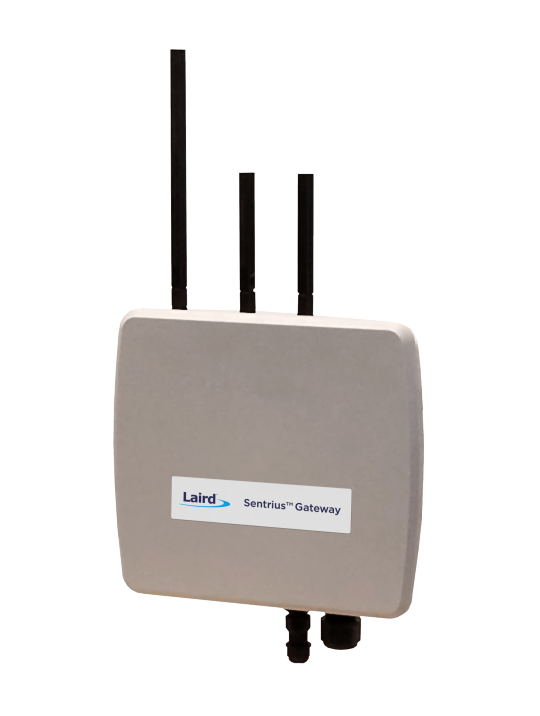
Multitech
Developer resource http://www.multitech.net/developer/products/multiconnect-conduit-platform/
Retail 675–685 US dollars
Breakdown: base gateway MTCDT-H5–210L-US-EU-GB https://www.digikey.com/product-detail/en/multi-tech-systems-inc/MTCDT-H5-210L-US-EU-GB/881-1236-ND/5246365() $490, antenna (https://www.digikey.com/product-detail/en/multi-tech-systems-inc/AN868-915A-10HRA/881-1242-ND/5246371) $13, LoRa module MTAC-LORA-915 (https://www.digikey.com/product-detail/en/multi-tech-systems-inc/MTAC-LORA-915/881-1239-ND/5246368) $180
The MultiConnect® Conduit™ is a configurable, scalable cellular communications gateway for industrial IoT applications. Conduit allows users to plug in two MultiConnect mCard™ accessory cards supporting wired or wireless interfaces. It counts with open source Linux development, wwo mcard slots, Lora 8 channel receiver, Spred spectrum frequency hopping that is ued to Up to 10 miles line of sight. MultiConnect has done a great job with its documentation and it counts with its own platform that can be used as well.

Lorrier LR2
Details at: https://lorrier.com/#introducing-lr2
Developer resource: https://github.com/lorriercom
Retail €615.00 €755.00
Based on LoRaWAN™ protocol. This is a fully outdoor device intended to establish a wide coverage network by telecommunications operators and local network by individuals or IoT connectivity service providers. The whole solution, including both HW and SW parts, follows the Lorrier culture, and it is shared as an Open Source.
The gateway is based on iC880a LoRaWAN™ concentrator by IMST which uses Semtech SX1301 base band processor designed for use with LoRa® networks. BeagleBone Green with 1GHz (2000 MIPS) processor and fully operational on fast SPI bus was chosen as a powerful control unit.

LoRa/LoRaWAN Gateway — 915MHz for Raspberry Pi 3
Details at https://www.seeedstudio.com/LoRa%2FLoRaWAN-Gateway-915MHz-for-Raspberry-Pi-3-p-2821.html
Retails 289.00 US dollars
If you want to build you own LoRa network, there are 3 things that you should prepare to get started: a Gateway, at least one Node and a local server where you can monitor all your devices. This kit provides a gateway & local server that allows you to collect and transfer data among all your LoRa nodes. By connecting the gateway with Seeeduino LoRaWAN and Grove modules, you can build your IOT prototype within minutes.
Regarding the gateway module RHF0M301, it is a 10 channel(8 x Multi-SF + 1 x Standard LoRa + 1 x FSK) LoRaWan gateway moduel with a 24pin DIP port on board, users can easily connect the RHF0M301 with PRI 2 bridge RHF4T002, adapter for Raspberry Pi 3 and RHF0M301.

RisingHF gateway
Details at http://www.risinghf.com/product/rhf0m301/?lang=en
I have seen this solution mentioned and used across the LoRaWAN community. Its technical specs are RHF0M301 is a 10 channels (8 x Multi-SF + 1 x Standard LoRa + 1 x FSK) LoRa/LoRaWAN gateway or concentrator module. The module is integrated one 24 pins DIP hearder, with this header user could connect RHF0M301 with his own embedded platform to build a customized gateway easily.
LG01 LoRa OpenWrt IoT Gateway by Dragino Tech
Details at https://www.tindie.com/products/edwin/lg01-lora-openwrt-iot-gateway/?pt=ac_prod_search
Retails 56.00 US dollars
This gateway is a long distance wireless 433/868/915Mhz, OpenWrt, LoRa IoT Gateway
The LG01 is an open source single channel LoRa Gateway. It lets you bridge LoRa wireless network to an IP network via WiFi, Ethernet, 3G or 4G cellular.
DYI options:
There are various posts on DYI options based both from Raspberry Pi and Arduino boards. Below are a few:
Build your own gateway
https://www.thethingsnetwork.org/docs/gateways/start/build.html
Building a Raspberry Pi Powered LoRaWAN Gateway
https://www.rs-online.com/designspark/building-a-raspberry-pi-powered-lorawan-gateway
Hardware IMST iC880A LoRaWAN “concentrator” board and Raspberry Pi
The iC880A — LoRaWAN https://wireless-solutions.de/products/long-range-radio/ic880a iC880A is able to receive packets of different end devices send with different spreading factors on up to 8 channels in parallel. In combination with an embedded Linux board like Raspberry Pi, Beagle Bone, Banana Pi and the HAL software from https://github.com/Lora-net a complete LoRaWAN® gateway can be setup easily.
From zero to LoRaWAN in a weekend
https://github.com/ttn-zh/ic880a-gateway/wiki
Based iC880a concentrator board and a Raspberry Pi 2.
A DIY low-cost LoRa gateway
http://cpham.perso.univ-pau.fr/LORA/RPIgateway.html
The gateway is based on a Raspberry PI. RPI 1B+/2B/3B can be used. The LoRa modules comes from (a) Libelium LoRa radio module, (b) HopeRF RFM92W/HopeRF RFM95W (or RFM96W for 433MHz), © Modtronix inAir9/inAir9B (or inAir4 for 433MHz), (d) NiceRF LoRa1276. Libelium LoRa and RFM92W use the Semtech SX1272 chip while RFM95W, inAir9/9B and NiceRF LoRa1276 use the SX1276 which is actually more versatile.
Note: The LoRa module and the LoRaWAN module are not compatible because the protocols are different. The LoRa module implements a simple link protocol, created by Libelium. However, the LoRaWAN module runs the LoRaWAN protocol, a much richer and more advanced protocol, created by the LoRa Alliance.
Check out their Github page with detailed documentation https://github.com/CongducPham/LowCostLoRaGw
Conclusion on gateways:
The gateway is a key portion of this solution given that the sensors will need to send the information “somewhere” where it can either be analyzed on the edge or sent to the cloud. After considering price ranges on both the parts needed for a DIY solution or a full blown gateway I considered those solutions that would be cost effective and which I was most familiar with. The “LG01 LoRa OpenWrt IoT Gateway by Dragino Tech” seemed the best approach. The developer kit counts with an Arduino developer node and a Developer gateway. Note that this solution only counts with ONE channel, in comparison with other solutions that allow 8+ channels. This was a compromise that was evaluated and given that this will be a prototype the one channel option seemed sufficient.
In the following articles I will showcase both the remaining hardware parts and the software portion along with updates on how the project is coming along.
17 notes
·
View notes
Photo
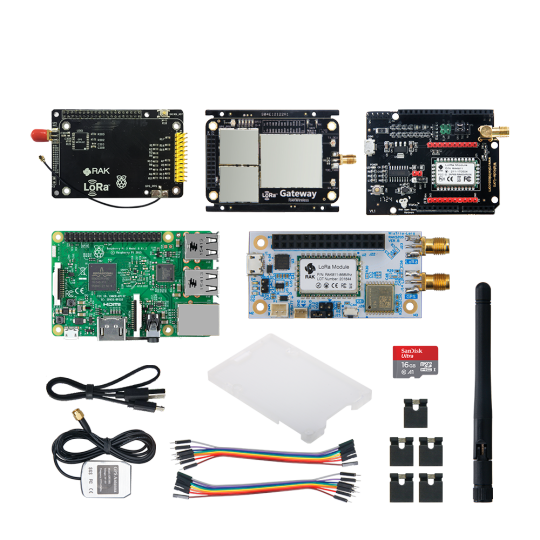
Lora Gateway Kit
Among the devices that you should heavily invest on is a Lora Gateway kit. LoRa gateways are routers that receive a device’s message and forward it to the IoT network. A single gateway can help and serve thousands of devices already.
Key Features
RAK831 LPWAN Module with Raspberry Pi3 and MAX-7Q GPS Module, based on SX1301, 433/868/915MHz.
Support 433MHz / 868MHz / 915MHz communication band
Based on Semtech SX1301, half-duplex gateway module
Support 10 channels, 8 downlink and 1 uplink channel, 1 FSK channel
RF output power of 25.2dBm
Receiving sensitivity up to -139dBm, up to 15KM
0 notes
Link
For just $175.00 Feature:Operating Voltage: DC5VOperating Temperature: -40°C to +85°CRadio Chipset: SX1301RF Output Power: 23dBmReceiver Sensitivity: Up to -142.5dBm (@293bps)GPS Receiver: IncludesSNR handling: 9dBControl Interface: SPIDimension: 80 x 50 x 5mmFirmware: Gateway HALRange: Up to 15KMFree World Shipping !quency band 433MHz/868MHz/915MHZ (Optional)Package inlcudes:1 x Module1 x Antenna
0 notes
Text

Does the Location Differ Based on the Different Operating Frequencies of 433MHz LoRa Modules?
The 433MHz LoRa module is a type of LoRa wireless communication module that operates in the 433MHz frequency band. LoRa is a low-power, long-range communication technology suitable for applications like the Internet of Things (IoT), remote monitoring, and smart homes. The 433MHz frequency denotes that this module operates at 433MHz, which falls into the lower frequency range, offering excellent penetration capabilities and transmission distances. Besides 433MHz, LoRa modules can also operate at other common frequencies such as 868MHz, 915MHz, and 2.4GHz.
Typically, a 433MHz LoRa module comprises two parts: a transmitter and a receiver. The transmitter is responsible for encoding and modulating data using LoRa technology and sending it, while the receiver's task is to capture and demodulate received signals, converting them into usable data. These modules often boast extended communication ranges, reaching several kilometers in open environments.
The transmission characteristics at different frequencies of LoRa modules correspond to various application scenarios:
Communication Range: In general, lower operating frequencies result in longer communication ranges for LoRa modules. This is because lower-frequency signals can penetrate obstacles like buildings and vegetation more effectively. Therefore, lower-frequency LoRa modules (e.g., 433MHz) are suitable for scenarios requiring long-distance communication.
Transmission Speed: LoRa modules operating at higher frequencies typically offer higher transmission speeds. High-frequency LoRa modules (such as 915MHz or 2.4GHz) can achieve faster data transmission rates over shorter distances. This makes them suitable for applications requiring rapid data transfer, such as real-time monitoring and remote control.
Penetration Capability: Lower-frequency LoRa modules generally exhibit better penetration capabilities, allowing them to penetrate buildings and obstacles more effectively. In contrast, high-frequency LoRa modules may experience some interference or attenuation during transmission, limiting their communication range.
The choice of the appropriate LoRa module operating frequency should be based on specific application requirements and communication environments. Lower-frequency modules are suitable for long-distance communication and challenging signal penetration conditions, while higher-frequency modules are ideal for fast data transmission and shorter-range communication. In IoT applications, the 433MHz LoRa module is commonly used for collecting and transmitting sensor data, such as monitoring environmental parameters like temperature, humidity, and air pressure. It also finds widespread use in wireless remote control, wireless alarms, smart homes, and more.
The LoRaCC68 series of wireless LoRa modules is designed using Semtech's LLCC68 chip. These modules have a receiving current of less than 5mA, a sleep current of 0.56~2.9mA, and a sensitivity of -129dBm. They feature a built-in 64KHz crystal oscillator, allowing timed wake-up of the microcontroller in low-power scenarios. The module's antenna switch is controlled internally, saving external MCU resources. With a compact size and an output power of 22dBm (160mW), LoRaCC68 modules have a significant advantage in IoT and battery-powered applications. The LoRaCC68 can be customized for the following frequencies.
The LoRa-CC68-X1 module is the smallest in the entire series, with dimensions as shown in the following diagram.
In summary, the 433MHz LoRa module is a LoRa wireless communication module that operates in the 433MHz frequency band. Due to its lower operating frequency, it offers longer communication range and better penetration capabilities. With the low power consumption and high interference resistance brought about by LoRa module's spread spectrum technology, it is suitable for applications in wireless remote control, wireless alarms, smart homes, and more.
For details, please click:https://www.nicerf.com/item/sx1278-lora-module-lora1278-c1
Or click:
For consultation, please contact NiceRF (Email: [email protected])
0 notes
Text
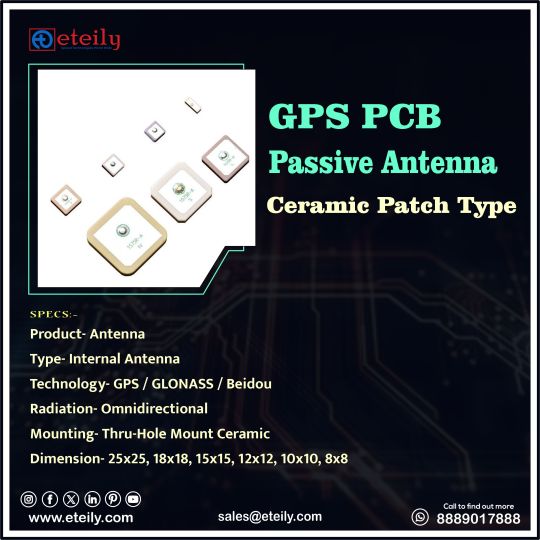
Eteily Technologies India Pvt Ltd
GPS PCB Passive Antenna Ceramic Patch Type
SPECS :
1. Product- Antenna
2. Type-Internal Antenna
3. Technology- GPS/GLONASS/Beidou
4. Radiation-Omnidirectional
5. Mounting-Thru-Hole Mount Ceramic
6. Dimension-25x25, 18x18, 15x15, 12x12, 10x10, 8x8
For More Info -
+91 88890 17888
#eteily#technologies#eteilyindia#telecom#telecommunications#gps#gpstracker#gpsantenna#pcb#india
#gps antenna#gps antenna manufacturer#gnss antenna#gps antenna for car#garmin gps antenna#garmin antenna#trimble gps antenna#gps active antenna#gps patch antenna#external gps antenna#gps antenna types#usb gps antenna#nmea 2000 gps antenna#external gps#marine gps antenna#one lap gps#iridium gps#passive gps antenna#gps antenna for ipad#tracking antenna#fakra gps antenna#neo 6m gps module with arduino#lowrance gps puck
0 notes
Text
Mini IOT Lora Gateway LoraWan SX1301 sx1255/57 lora 8 Channel 915MHZ for Gateway Integrated for Raspberry Pi with esp32 lora node/stm32 lora Node (Package C)
Product Description
CE Certificate
SX1301 digital baseband chip
Size: 66(+10) x 30 x 15mm (can assemble with raspberry pi ZERO via a special converter board)
Emulates 49x LoRa demodulators and 1x (G)FSK demodulator
10 programmable parallel demodulation paths
Dynamic data-rate adaptation (ADR)
Automatic adaptive spread spectrum factor, SF7 to SF12 for each channel is optional
Maximum output: 20 ± 1dBm
Up to -139dBm sensitivity with SX1257 or SX1255 Tx/Rx front-end
Communication interface SPI or USB
The power supply voltage:5V
Support for LoRaWAN Class A, Class B, Class C protocols
Through the unique heat conduction device to transfer heat to the aluminum housing, strengthen heat dissipation, make the operation more stable
-20°C to 70°C maximum operating temperature range
Frequency range:
Europe – 868MHz ISM band (863MHz to 870MHz range)
Europe – 433MHz ISM band
USA/Australia – 915MHz ISM band (902MHz to 928MHz range)
China – 470MHz ISM band (470MHz to 510MHz range)
Product Features
Instruction: https://drive.google.com/file/d/17fbK6orHuUwrphHk6m6q8UHtZ97ckRm5/view?usp=sharing. Mini Lora Gateway: The core chip of the HT-M01 LoRa gateway is the SX1301 baseband chip.It’s industrial-grade standard LoRa/LoRaWAN gateway module which with high performance and small size. This LoRa Gateway is mainly aimed at wireless sensor networks, Internet of things, embedded applications, it can help customers quickly complete the development of LoRaWAN networking working with our product.
Mini Lora Gateway: Can connect to 1000+ lora node, the erection height is more than 60m and the effective transmission and reception distance of the measured open area data is 17km; Support run on windows.
Ultra-small size Pretty Design-The shell is made of aluminum alloy material CNC precision machining and it’s surface treated with sandblasting oxidation,suit for raspberry pi zero;can be integrated for Raspberry Pi through dedicated adapter board;
Various Adaptation- Support usb,SPI communication; Easy to Install-It can be used after installing
General scene-Easy to work in big scene; Unique thermal design-Making the huge heat produced by HT-M01 LoRa Gateway can be conducted to the aluminum shell through speciall heat transfer device, which strengthened heat dissipation function and confirmed the stablility.
The post Mini IOT Lora Gateway LoraWan SX1301 sx1255/57 lora 8 Channel 915MHZ for Gateway Integrated for Raspberry Pi with esp32 lora node/stm32 lora Node (Package C) appeared first on The Ram Memory Store.
The article was originally published here!
Mini IOT Lora Gateway LoraWan SX1301 sx1255/57 lora 8 Channel 915MHZ for Gateway Integrated for Raspberry Pi with esp32 lora node/stm32 lora Node (Package C)
0 notes
Text
Mini IOT Lora Gateway LoraWan SX1301 sx1255/57 lora 8 Channel 915MHZ for Gateway Integrated for Raspberry Pi with esp32 lora node/stm32 lora Node (Package C)
Product Description
CE Certificate
SX1301 digital baseband chip
Size: 66(+10) x 30 x 15mm (can assemble with raspberry pi ZERO via a special converter board)
Emulates 49x LoRa demodulators and 1x (G)FSK demodulator
10 programmable parallel demodulation paths
Dynamic data-rate adaptation (ADR)
Automatic adaptive spread spectrum factor, SF7 to SF12 for each channel is optional
Maximum output: 20 ± 1dBm
Up to -139dBm sensitivity with SX1257 or SX1255 Tx/Rx front-end
Communication interface SPI or USB
The power supply voltage:5V
Support for LoRaWAN Class A, Class B, Class C protocols
Through the unique heat conduction device to transfer heat to the aluminum housing, strengthen heat dissipation, make the operation more stable
-20°C to 70°C maximum operating temperature range
Frequency range:
Europe – 868MHz ISM band (863MHz to 870MHz range)
Europe – 433MHz ISM band
USA/Australia – 915MHz ISM band (902MHz to 928MHz range)
China – 470MHz ISM band (470MHz to 510MHz range)
Product Features
Instruction: https://drive.google.com/file/d/17fbK6orHuUwrphHk6m6q8UHtZ97ckRm5/view?usp=sharing. Mini Lora Gateway: The core chip of the HT-M01 LoRa gateway is the SX1301 baseband chip.It’s industrial-grade standard LoRa/LoRaWAN gateway module which with high performance and small size. This LoRa Gateway is mainly aimed at wireless sensor networks, Internet of things, embedded applications, it can help customers quickly complete the development of LoRaWAN networking working with our product.
Mini Lora Gateway: Can connect to 1000+ lora node, the erection height is more than 60m and the effective transmission and reception distance of the measured open area data is 17km; Support run on windows.
Ultra-small size Pretty Design-The shell is made of aluminum alloy material CNC precision machining and it’s surface treated with sandblasting oxidation,suit for raspberry pi zero;can be integrated for Raspberry Pi through dedicated adapter board;
Various Adaptation- Support usb,SPI communication; Easy to Install-It can be used after installing
General scene-Easy to work in big scene; Unique thermal design-Making the huge heat produced by HT-M01 LoRa Gateway can be conducted to the aluminum shell through speciall heat transfer device, which strengthened heat dissipation function and confirmed the stablility.
The post Mini IOT Lora Gateway LoraWan SX1301 sx1255/57 lora 8 Channel 915MHZ for Gateway Integrated for Raspberry Pi with esp32 lora node/stm32 lora Node (Package C) appeared first on The Ram Memory Store.
The article was originally published here!
Mini IOT Lora Gateway LoraWan SX1301 sx1255/57 lora 8 Channel 915MHZ for Gateway Integrated for Raspberry Pi with esp32 lora node/stm32 lora Node (Package C)
0 notes
Text
Mini IOT Lora Gateway LoraWan SX1301 sx1255/57 lora 8 Channel 915MHZ for Gateway Integrated for Raspberry Pi with esp32 lora node/stm32 lora Node (Package C)
Product Description
CE Certificate
SX1301 digital baseband chip
Size: 66(+10) x 30 x 15mm (can assemble with raspberry pi ZERO via a special converter board)
Emulates 49x LoRa demodulators and 1x (G)FSK demodulator
10 programmable parallel demodulation paths
Dynamic data-rate adaptation (ADR)
Automatic adaptive spread spectrum factor, SF7 to SF12 for each channel is optional
Maximum output: 20 ± 1dBm
Up to -139dBm sensitivity with SX1257 or SX1255 Tx/Rx front-end
Communication interface SPI or USB
The power supply voltage:5V
Support for LoRaWAN Class A, Class B, Class C protocols
Through the unique heat conduction device to transfer heat to the aluminum housing, strengthen heat dissipation, make the operation more stable
-20°C to 70°C maximum operating temperature range
Frequency range:
Europe – 868MHz ISM band (863MHz to 870MHz range)
Europe – 433MHz ISM band
USA/Australia – 915MHz ISM band (902MHz to 928MHz range)
China – 470MHz ISM band (470MHz to 510MHz range)
Product Features
Instruction: https://drive.google.com/file/d/17fbK6orHuUwrphHk6m6q8UHtZ97ckRm5/view?usp=sharing. Mini Lora Gateway: The core chip of the HT-M01 LoRa gateway is the SX1301 baseband chip.It’s industrial-grade standard LoRa/LoRaWAN gateway module which with high performance and small size. This LoRa Gateway is mainly aimed at wireless sensor networks, Internet of things, embedded applications, it can help customers quickly complete the development of LoRaWAN networking working with our product.
Mini Lora Gateway: Can connect to 1000+ lora node, the erection height is more than 60m and the effective transmission and reception distance of the measured open area data is 17km; Support run on windows.
Ultra-small size Pretty Design-The shell is made of aluminum alloy material CNC precision machining and it’s surface treated with sandblasting oxidation,suit for raspberry pi zero;can be integrated for Raspberry Pi through dedicated adapter board;
Various Adaptation- Support usb,SPI communication; Easy to Install-It can be used after installing
General scene-Easy to work in big scene; Unique thermal design-Making the huge heat produced by HT-M01 LoRa Gateway can be conducted to the aluminum shell through speciall heat transfer device, which strengthened heat dissipation function and confirmed the stablility.
The post Mini IOT Lora Gateway LoraWan SX1301 sx1255/57 lora 8 Channel 915MHZ for Gateway Integrated for Raspberry Pi with esp32 lora node/stm32 lora Node (Package C) appeared first on The Ram Memory Store.
The article was originally published here!
Mini IOT Lora Gateway LoraWan SX1301 sx1255/57 lora 8 Channel 915MHZ for Gateway Integrated for Raspberry Pi with esp32 lora node/stm32 lora Node (Package C)
0 notes
Text
Mini IOT Lora Gateway LoraWan SX1301 sx1255/57 lora 8 Channel 915MHZ for Gateway Integrated for Raspberry Pi with esp32 lora node/stm32 lora Node (Package C)
Product Description
CE Certificate
SX1301 digital baseband chip
Size: 66(+10) x 30 x 15mm (can assemble with raspberry pi ZERO via a special converter board)
Emulates 49x LoRa demodulators and 1x (G)FSK demodulator
10 programmable parallel demodulation paths
Dynamic data-rate adaptation (ADR)
Automatic adaptive spread spectrum factor, SF7 to SF12 for each channel is optional
Maximum output: 20 ± 1dBm
Up to -139dBm sensitivity with SX1257 or SX1255 Tx/Rx front-end
Communication interface SPI or USB
The power supply voltage:5V
Support for LoRaWAN Class A, Class B, Class C protocols
Through the unique heat conduction device to transfer heat to the aluminum housing, strengthen heat dissipation, make the operation more stable
-20°C to 70°C maximum operating temperature range
Frequency range:
Europe – 868MHz ISM band (863MHz to 870MHz range)
Europe – 433MHz ISM band
USA/Australia – 915MHz ISM band (902MHz to 928MHz range)
China – 470MHz ISM band (470MHz to 510MHz range)
Product Features
Instruction: https://drive.google.com/file/d/17fbK6orHuUwrphHk6m6q8UHtZ97ckRm5/view?usp=sharing. Mini Lora Gateway: The core chip of the HT-M01 LoRa gateway is the SX1301 baseband chip.It’s industrial-grade standard LoRa/LoRaWAN gateway module which with high performance and small size. This LoRa Gateway is mainly aimed at wireless sensor networks, Internet of things, embedded applications, it can help customers quickly complete the development of LoRaWAN networking working with our product.
Mini Lora Gateway: Can connect to 1000+ lora node, the erection height is more than 60m and the effective transmission and reception distance of the measured open area data is 17km; Support run on windows.
Ultra-small size Pretty Design-The shell is made of aluminum alloy material CNC precision machining and it’s surface treated with sandblasting oxidation,suit for raspberry pi zero;can be integrated for Raspberry Pi through dedicated adapter board;
Various Adaptation- Support usb,SPI communication; Easy to Install-It can be used after installing
General scene-Easy to work in big scene; Unique thermal design-Making the huge heat produced by HT-M01 LoRa Gateway can be conducted to the aluminum shell through speciall heat transfer device, which strengthened heat dissipation function and confirmed the stablility.
The post Mini IOT Lora Gateway LoraWan SX1301 sx1255/57 lora 8 Channel 915MHZ for Gateway Integrated for Raspberry Pi with esp32 lora node/stm32 lora Node (Package C) appeared first on The Ram Memory Store.
The article was originally published here!
Mini IOT Lora Gateway LoraWan SX1301 sx1255/57 lora 8 Channel 915MHZ for Gateway Integrated for Raspberry Pi with esp32 lora node/stm32 lora Node (Package C)
0 notes
Link
If you need the 915Mhz version, please buy Product ID: 1239769 Description: The 868MHz antenna needs to be in connection with the IPEX interface (if the antenna is not connected, it may damage ...
0 notes